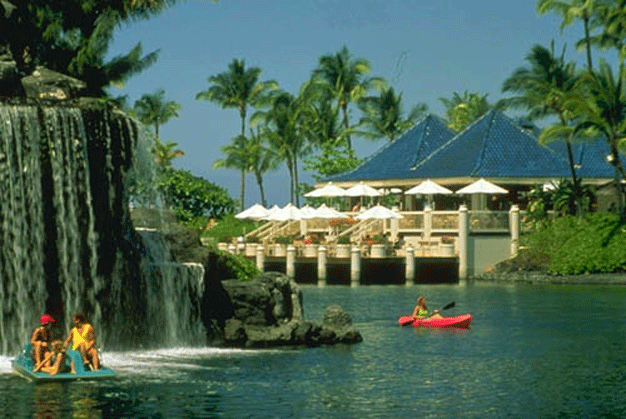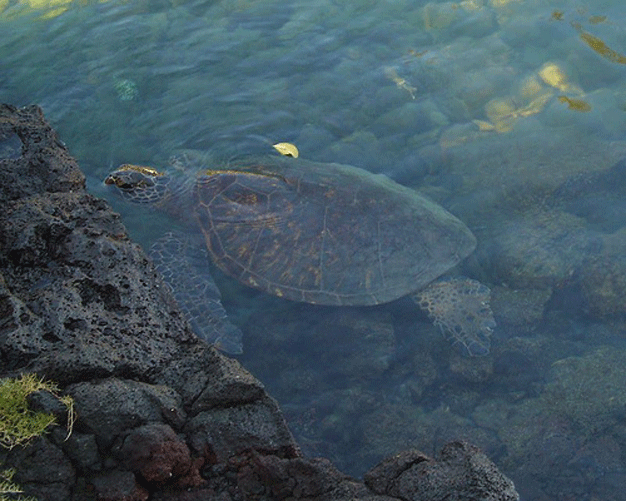
After you read this, or print this, or whatever... you can click here to get back to the home page.
IF IT'S TEN YEARS, THIS MUST BE HAWAII
Chuck And Sue And Ken And Deborah On The Big Island
PART TWO
If you could pick one word that best characterized this trip (or life in general, for that matter) it would be "snorkeling."
Ken really likes to snorkel. I, on the other hand, had never been snorkeling prior to this trip. (I do, however, like saying the word... snorkel, snorkel, snorkel).
In order to keep the government grant for maintaining an educational website, let me tell you a little bit about snorkeling.
Snorkeling is the technical term used to describe the complex process of breathing through a tube in a non-medical setting. (Hospitals used to use the term until they started receiving calls from panicked patients who noticed a "snorkeling" charge on the itemized bill and demanded to know what had been done to them). Snorkeling didn't gain much popularity till someone discovered that it actually made sense if your head was underwater. Then it soon became the rage among road gang escapees trying to shake bloodhounds.
Nowadays, snorkeling is considered a form of recreational swimming
practiced by folks who want to get a prolonged gander at undersea life,
but don't see the wisdom of going into the water with high-pressure
metal tanks strapped to their backs. Technically, the "snorkel" is the
U-shaped tube that goes into one's mouth and, in theory, sticks out of
the water while one swims face-down. But the snorkel (noun) is only one
of the pieces of equipment needed to snorkel (verb). You should also
have:
- a swim mask;
- swimming fins;
- a pair of swim trunks, preferably ones that will stay on while you're
swimming.
The simplicity of the equipment makes snorkeling a bit more accessible than scuba diving. Also, technically, you have to complete some training to go scuba diving, but any idiot can chomp down on a snorkel. That's where I come in.
Like I said, I had no previous snorkel experience, but from its inception, it was clear that this Hawaii trip was going to be my baptism (so to speak) into the discipline of remote breathing. In the months preceding the vacation, Ken kept asking me if I would be his snorkeling buddy during the trip, and, of course I agreed. I usually agree to any activity Ken suggests. I assume it's because we're friends, so we have fun doing just about anything, but some have suggested he has a Svengali-like influence on me that causes me to participate in otherwise out-of-character endeavors. On reflection they may have a point... in the past, the man has finagled me onto the back of a motorcycle on the freeway; convinced me to throw myself over a jet turbine to simulate sky-diving; and, when we were stranded by riptides off a California beach, had me towed back to shore by a lifeguard half my size. If he hadn't become a Christian, I'd probably be reminiscing about our stay in a Guatemalan prison.
Ken has the cockeyed notion that his vacations should be spent doing things he enjoys. He enjoys eating, sleeping, reading, watching TV, visiting with friends and family, and snorkeling. If he could somehow install a coral reef in his back yard, Ken's perfect vacation spot would be his home.
He does NOT enjoy sightseeing. For Ken, a picture is worth a thousand miles. His outlook is that people have gone to a lot of trouble to photograph pretty much everything that's worth looking at. So he sees no appeal in taking the time and effort to travel somewhere just so he can say he's seen it in person.
Hey, everybody enjoys different things, so this is a perfectly valid point of view... but it's not one shared by everyone. For instance, I like road trips... taking my car to places I've never been, and looking at everything along the way. If Ken took a trip like that with me, it would probably have the same ending as Thelma and Louise. So you can see that, hypothetically speaking, if someone with Ken's recreational philosophy is grouped with other folks who enjoy sightseeing and they're all dropped into an incredibly picturesque and unique location like Hawaii; well, speaking strictly hypothetically, it might put a damper on Susan and Deborah's plans for a good time.
If, on the other hand, there were someone there to take up the snorkel slack, the hypothetical women could peel off for their own activities without leaving Ken to his own aquatic devices. But where could such a person be found? Someone with no pre-conceived notion of what constitutes an Hawaiian vacation; someone whose putty-like mind could easily be convinced that taking his putty-like body out for a daily snorkel with his friend was the epitome of a tropical-good time?
As I said, Ken had written the job description with me in mind, so I was perfect for the part, except for my utter lack of experience. But Ken was very patient dealing with a guy who didn't know which end of the snorkel to put in which end of his body.
The first day, we decided to take baby steps and stick to the private ocean-fed lagoon inside the resort:

We rented the snorkel gear from a shack located on the little beach that's just out of frame to the right. After seeing me, they upped the security deposit to cover cover the expense of dragging the lagoon bottom to recover their equipment and (for five dollars more) me.
As we suited up, Ken gave me a crash course in snorkelology. Rule #1: don't breathe through your nose. That was a tough one for me. I use my nose a lot for breathing, mostly because my mouth is usually occupied with eating something. Rationally, I knew the snorkel wasn't edible and would allow mouth-breathing, but the lizard brain that controls my reflexes still told my nose to kick in whenever I bit down on the mouthpiece. This is a big deal because if you exhale through your nose while snorkeling, you break the suction-generated seal between your face mask and your face, water pours into your face mask, and you can no longer clearly see your life flashing before your eyes.
Rule #2: If you dive below the surface, be sure to clear your snorkel if you ever manage to make it back to the surface. Apparently, while you're under the sea, water tries to sneak into your lungs through the snorkel tube, and at some point you have to drive back that advance. You do this summoning up elementary school memories of spitball battles and exhaling a sharp burst of air through the tube. The first time I tried this, my lizard brain and I were again at odds. I took a deep breath through the tube, held it, and went down for a closer look at the bottom. After about 10 seconds, my lungs were screaming for oxygen, so I went back up to get some more. Unfortunately, my first instinct after holding my breath is to suck in air, not blow more out. While I was discovering how bad the Pacific tastes, I reflected on why so many sports (snorkeling, sky-diving, rock-climbing, dodgeball) involve doing the exact opposite of what your body is suggesting at the time.
At any rate, after a bit of time devoted to a majestically-arced learning curve, I got the hang of it and started exploring the wonders of the ocean floor which, in this lagoon, was mostly suspended throughout the water. There's a lot of people doing a lot of stuff in the lagoon--- swimming; pedal-boating; kayaking; rowing around on some sort of stand-up surfboard arrangement; playing Marco Polo; looking for the bar--- and they tend to kick up a lot of silt that would otherwise be resting peacefully at the bottom. So, visibility-wise, swimming around in it is like taking a dip in a strong pot of Earl Grey tea. Still, you could see something if you got close enough to it to make it feel uncomfortable, and the lagoon was a nice, non-threatening place to break in a snorkel.
Part of the lagoon sea-life that's decided to put up with the tourists are a couple of sea turtles like the one below.

There are signs throughout the lagoon letting folks know that the turtles are for watching, not touching or riding or trying to put in your suitcase. Unfortunately, unlike dolphins, turtles can't read, and the ones in the lagoon treat it like a cocktail party. If you're anywhere near them, they bump up against you or come up underneath you and try to slip you their telephone numbers.
Seeing as how I didn't get intimately acquainted with a lifeguard, we thought the first day of snorkeling went pretty well. So, for the following day, we planned a trip out to a real beach.
COMING NEXT: BLOOD IN THE WATER